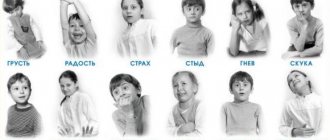Emotions and feelings, difference
There are two levels of the human condition - emotions and feelings. They are often confused with each other. What is their difference? Let me make a reservation right away that I do not use ready-made formulations, but write in the mode of a special opinion based on the synthesis and analysis of existing knowledge and practice, first of all. Therefore, I will immediately voice a specific opinion.
- Emotions arise as a response to an external stimulus and the demands of the mind, so a surge of emotions arises only as a derivative of the mind and the external factor of irritation of the senses.
- A feeling is a consequence of human thought, that is, a feeling appears as a mental experience of human thought. We know that thought is timeless, therefore all-encompassing feeling is characterized by infinity, that is, feeling is a cosmic quality.
In connection with the above, for greater understanding, let us define emotions and feelings as smaller and larger manifestations of the human soul.
Here's an example:
A person saw something unexpectedly or even just by accident. The reaction to this phenomenon is an emotional outburst, as a person’s defensive reaction to an external stimulus. Reason looks for a reason and if it finds it, then the emotion freezes; if reason cannot understand or explain, then the emotion turns into shock or reason transfers powers to the mind, which uses thought, thought in turn includes (I note - includes) feeling. A feeling is a spatial state, so a person easily tunes into the desired state against an emotional outburst, fear, for example, and acquires a form of equanimity that extinguishes fear at conception. But we'll talk about this below.
Feelings are a person’s mental experience as a result of the manifestation of thoughts in the process of their interaction.
I note that the interaction of thoughts and feelings in a person can certainly be called the human mind. If thought is information, then feeling shows an image of information in the form of a state and experience, fills the image with content and energy.
They say that what is felt means understood; emotion does not give understanding. They also say that you need to read with expression, that is, with feelings; emotion even blocks memory.
Why am I writing this? Just to show the difference between feelings and emotions. Please note that I do not use terms such as higher and lower, everything in its place is necessary and unique, we will deal with this below.
Read more to fully understand the difference between emotions and feelings. Any creative person understands what human feelings and emotions are. It doesn’t matter what he creates, writes a poem, a novel, or paints a picture, sculpts a sculpture, he works with feelings and only feelings.
“The storm covers the sky with darkness,
Whirling snow whirlwinds
The way the beast will howl,
Then he will cry like a child”...
While writing these lines, as well as while reading with expression, feelings appear, filling the words with great meaning.
Why are the works of classics so valued? The reason is simple: a talented creator creates a work of art using human feelings, not emotions.
Of course, it is possible to create something original and without feelings, but it will be a template or, as they say now, plywood. This state of affairs is widespread in the world, even among the so-called stars. Of course, there are still wonderful creative bursts, but they are very few and they are not popular among the masses of consumption and the market.
Society lives by emotions, and emotion is a one-time, superficial disturbance of energy, which is far from inspiration.
Of course, both emotions and feelings can be positive and negative, but this is a separate topic and we will not discuss it in this article.
Who can experience emotions?
Izard’s publication “The Psychology of Emotions” gives the reader a lot of interesting information for thought. So this is where you can learn about a provocative fact: even viruses can have emotions. According to some experts, they are capable of experiencing disgust if a toxic environment is nearby. According to the author, emotion is a necessary component of the evolution of a living being, without which its survival is impossible. After all, feelings motivate all types of animals to fight for their existence. Such manifestations of emotions are called basic. This is a more complex phenomenon than what we attribute to the sphere of physical sensations and needs.
When an animal wants to eat or experiences pain or cold, physical sensations work in it, which are the motive for action. However, even in comfortable conditions, a curious animal is ready to climb into a dark hole, where it is unknown what awaits it. This is the emotion of curiosity. Those animals that did not die along the way found new habitats and food sources for themselves. Any animal can be angered, and this too will only be an emotion. Emotions are experienced by a female who protects her cubs from harm, emotions are experienced by a male when he fights for his leadership in the pack.
Social psychology of personality begins from the moment when a small child discovers that he does not live alone in this world. From the first days of his life, he screams angrily if he wants to eat or if his tummy hurts. These are his very first emotions. In two months he will smile for the first time. This is evidence of those feelings that arose on their own, and not due to feelings of hunger or discomfort. This is the joy of seeing a loved one, the joy of existing.
Experts also consider interest to be an innate basic emotion. There is even an assumption that it is curiosity that every person experiences constantly and most of their life compared to other emotions. The only exception is the state of anger, as well as other very strong feelings when interest is temporarily lost
Many studies by psychologists are aimed at studying all forms of curiosity, since today attracting the attention of consumers is the basis of marketing, winning the attention of viewers is the goal of politics and art. The whole world is constantly studying how to win and retain the attention of large numbers of people.
Those who are looking for a soul mate never tire of typing in a search engine a query on how to attract the attention of a girl or guy.
Emotions and feelings - interaction from a psychological point of view
I will voice another component of the connection between emotions and feelings. Emotion can be used as an ignition spark to create a feeling, but here everything depends on the will of the person. An erupted emotion quickly fades, but if it is used to arouse feelings, then the emotion passes into a state of mind, quickly and painlessly.
For example, love at first sight. This is not a feeling yet, it is an emotion, like a reaction to a person of the opposite sex, but without the involvement of reason. When the mind is silent, the mind begins to work, which opens the feeling, feeding it through the memory of that very first sight.
The most beautiful thing for a person is the cooperation of emotion and feeling (less with more). In this case, all components of a person fulfill their role perfectly; as I already wrote, emotion is like an ignition spark for feeling, which instantly ignites thought and this knowledge.
Thought and feeling, under the action of imagination and will, have cosmic qualities, that is, they are directly connected with the highest consciousness of the Existing One.
Thus, with the correct interaction of human qualities, reason and thoughts, emotions and feelings, a person sees what exists and can use cosmic energies in everyday life, bypassing what the world of illusion (dogmas and stereotypes of consciousness) provides him with.
How emotions are born
Paul Ekman's book “The Psychology of Emotions” was created to find answers to frequently asked questions. The world of emotions still remains very little studied. The author began his work 40 years before its results began to be published. The writer began his research by studying the sensory sphere of people and its manifestation in different cultures. What commonality can be found between all peoples on earth when they show their emotions? What are the differences? The fact is that differences in the manifestation of feelings can shed light on which of them are amenable to education and the influence of others, and which are unchanged for all people on all continents?
The book is all the more interesting because the author did not limit himself to just one ethnic characteristic when studying, but conducted observations of mentally ill people, unbalanced people and those who look absolutely normal.
Main characteristics
One of the ways of transmitting and perceiving information is emotional coloring. We have taught our smartphones to convey facial expressions by sending the desired emoticon in a written message. It helps to express what we have experienced or experienced.
- Surprise, which provokes curiosity, encourages exploration and learning new things.
- Dislike helps protect against harmful and dangerous things and preserves health. It is associated with the instinct of self-preservation.
- Positivity brings joy and goodness; at the level of consciousness, it improves memory and develops erudition.
- Fear and cowardice, which protect against danger, make the reaction lightning fast.
- Rage and irritation are our self-defense; they sweep away obstacles like a hurricane and lead to achieving our goals.
- Melancholy and despondency bring not only dullness and apathy. When we are sad, we become closer to other people, stop the rush of events and pay attention to those aspects of life that were previously left outside.
To put it briefly, how emotions differ from feelings is that they are not private. For example, a family quarrel, the wife accused her husband of not having time to pick up the child from school. They speak in a raised voice and sound irritated and annoyed. But even if they were both silent, their faces, bodies and eyes would give them away. Most of our reactions have signals that clearly and easily communicate to others what we are feeling. While our thoughts remain inaccessible.
Psychologist Daria Milai
Make an appointment
Feelings in childhood
Carefree time, in fact, filled with hard work to form a personality, its emotional immunity, stability, resilience in difficult life situations. During this period, the foundations of empathy are laid, the lack of which in adult life is very difficult to cultivate and compensate for.
Factors of a child’s sensory development:
- formation of higher nervous activity;
- attitude of parents and other adults;
- communication with peers;
- features of the educational process;
- gradual expansion of the range of situations that evoke a response.
It is very important to teach your child not only to express, but also to distinguish between the experiences of other people. Relationships with parents are of particular importance in this. Being loved and loving, living in safety and affection, children open up, gain confidence and peace of mind for life.
Face-to-face consultation
What are the features and advantages of face-to-face consultation?
Find out more
Skype consultation
What are the features and benefits of Skype consultations?
Find out more
What do emotions affect?
The psychological characteristics of a person depend entirely on her emotions. We know about some people that they are often irritable and unfriendly. Others, on the contrary, are very nice. Some people have a very positive attitude towards their work because they love it or because they are satisfied with the conditions. Someone plans to leave their job because they like something else better. The choice of a friend and a bride, preferences in color, music, cooking, all this has one reason - emotions.
It is noteworthy that until the 1980s, psychology, as a science, tried to develop without a close study of the sensory sphere of human thinking, but paid more attention to the rational. As practical findings have shown, this was a mistake. The same gross mistake as studying the mind without taking into account the significance of the subconscious. Our consciousness often tells us one thing, and we order it something, but in reality something else happens. Feelings and reason are in constant conflict with each other, which sometimes creates very difficult conflicts to resolve.
Personality theories in psychology today certainly take into account the whole range of emotions that a person may experience regarding a particular topic. Otherwise, a huge layer of factors that influence his decision-making will be missed.
The fact is that with consciousness we cover only a very small part of the information that comes to us from the world around us. Most of the visual, auditory, olfactory and tactile signals remain outside the field of our memory, but all this is recorded by our brain. It leaves our reactions to certain stimuli deep in the subconscious. We sometimes cannot explain to ourselves why that particular shade of yellow is deeply unpleasant to us, or why we so want to eat this particular product.
Recent Entries
- 1. Features of psychology as a science, its tasks
- Types of student activities
- General concept of intelligence
- General characteristics of a person’s motivational sphere
- Diagnosis of selectivity of attention
- Conflicts as the struggle of animals for vital resources
- Subject and method of pedagogical conflictology
- Dr. Freud and his teachings
- Social ecology is a science and educational subject in the professional training of social work specialists
- Analysis of case studies of therapy
- Development of Russian psychology in the 19th century
- Basic principles and methods of managerial psychology 2
- Coping with difficult life situations
- Guidelines for conducting practical classes in sections 1−3 of the discipline “Psychology”
- in the course "Psychology" 2











